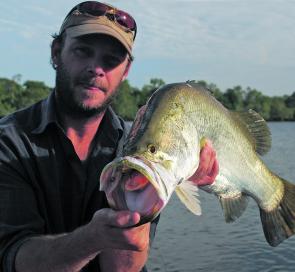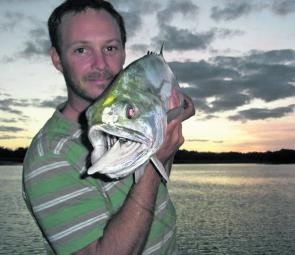May is a great time of year to roll out the medium spin and offshore tackle and begin chasing tropical speedsters up in Cape York. Some encouraging reports are coming in from charter operators of longtail tuna, queenfish, mackerel and trevally working bait schools in near shore waters.
Cape York has a huge assortment of shallow bays on the east coast and sheltered stretches on the west coast. Some years the pelagic species invade these areas earlier than others, smashing and slashing their way through tight balls of baitfish.
It’s a smorgasbord of options for anglers when these tropical speedsters are around, providing some of the most consistent light-tackle sport fishing anywhere along the Australian coastline.
While the larger estuaries of the west coast are still spewing out the last of their nutrient filled waters following the wet season, smaller pelagic species will be gathering around the mouths at this time of year.
Around the top of the tide and the first few hours of the run-out, baitfish gather over sand spits and shallow gutters. Hordes of brassy-trevally, giant herring, blue salmon and smaller queenfish will gather in veracious packs, proving great sport on small plastics, flies and metal slices.
Certain river mouths and upstream areas hold the giant queenfish, which perform acrobatic displays and drag-peeling runs that dreams are made of. At times these fish are hard to track down simply by casting poppers at fish working the surface. During these times, anglers can concentrate their efforts on a late afternoon incoming tide to troll hookless poppers behind the boat, stopping to cast at these fish once the water erupts behind the boat.
There is nothing quite like seeing a marauding pack of giant queenfish zeroing in on a popper or stick bait wound at breakneck speed across the surface. Sometimes they can get really carried away, smashing the surface presentations in a shower of bubbles and commotion only meters from the boat. Try and crimp your barbs and use either a single treble of stinger hook as these larger queenfish really fight hard and damage themselves in the process.
Some surprisingly large giant and golden trevally can make their way upstream this time of year. Chasing baitfish, prawns and other crustaceans up with larger tides, providing great tussles for those lucky enough to run into them. Joining them are queenfish, giant herring and mangrove jack found alongside saratoga and tarpon in some of the west coast rivers.
May is perhaps the nicest time of year to fish those upstream reaches above the rock and shallow sand bars which sometimes block the rivers from boat travel later in the year.
Without any massive wet season flushes, some of the east and west coast rivers begin to get sand and mud build up in the midstream reaches. During neap tides and the bottom of spring tides, navigation can be hazardous and at times impossible. This presents two opportunities for fishers.
Firstly, to those who take smaller, flat bottomed punts to those challenging upstream reaches. Secondly for those coming overland to reach those brilliant freshwater fishing holes just up from the saltwater influence.
These areas are amongst my favourite spots to target larger barramundi, black bream and saratoga amongst snags and rock bar areas. Walking to reach those vegetation-shrouded head and tail areas of large freshwater pools is my idea of exhilarating fishing. Scanning the shadows of a large melaleuca tree and finding a big barra finning gently in the current is a sight not quickly forgotten.
Make the most of your opportunities in May and get your fix of lure fishing for barramundi before the first serious drops in water temperature take hold.
Reads: 846
A chunky barra caught in the fresh above the tidal influence.

Large giant trevally will be holding around bait.

A nice upstream queenfish taken just on dusk.

This big golden trevally was hooked under a bait school.




